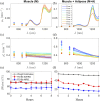Frequency domain broadband short-wave infrared spectroscopy for measurement of tissue optical properties from 685 to 1300 nm
- PMID: 40292022
- PMCID: PMC12022801
- DOI: 10.1117/1.JBO.30.4.045001
Frequency domain broadband short-wave infrared spectroscopy for measurement of tissue optical properties from 685 to 1300 nm
Abstract
Significance: Extending frequency domain diffuse optical spectroscopy (FD-DOS) into the short-wave infrared (SWIR) region has the potential to improve measurements of key biological tissue chromophores such as water and lipids, given their higher absorption in SWIR compared with near-infrared wavelengths. Few studies have explored FD-DOS in the SWIR range.
Aim: We present the first demonstration of a frequency domain broadband SWIR spectroscopy (FD-Bb-SWIRS) system to measure optical properties from 685 to 1300 nm.
Approach: A custom hybrid system was developed, combining discrete frequency domain measurements from 685 to 980 nm with broadband continuous wave measurements from 900 to 1300 nm. This setup provided absolute absorption ( ) spectra from 685 to 1300 nm. Validation was performed using mineral oil-based solid phantoms, deuterium oxide ( ) liquid phantoms, and desiccating porcine tissue.
Results: The FD-Bb-SWIRS system was sensitive to changes in from varying concentrations of absorbers in solid and liquid phantoms. Ex vivo measurements of spectra indicated differences in tissue water content across different porcine tissue samples during baseline and desiccation.
Conclusions: FD-Bb-SWIRS is highly sensitive to in the 685 to 1300 nm range and enables precise quantification of water in biological tissues. It represents a significant step forward in advancing SWIR-based optical spectroscopy for clinical applications.
Keywords: absorption spectra; diffuse optics; lipids; shortwave infrared light; water.
© 2025 The Authors.
Figures










Similar articles
-
Validation of subpixel target detection and linear spectral unmixing techniques on short-wave infrared hyperspectral images of collagen phantoms.J Biomed Opt. 2025 Feb;30(2):023518. doi: 10.1117/1.JBO.30.2.023518. Epub 2025 Feb 25. J Biomed Opt. 2025. PMID: 40008292 Free PMC article.
-
Short-Term Memory Impairment.2024 Jun 8. In: StatPearls [Internet]. Treasure Island (FL): StatPearls Publishing; 2025 Jan–. 2024 Jun 8. In: StatPearls [Internet]. Treasure Island (FL): StatPearls Publishing; 2025 Jan–. PMID: 31424720 Free Books & Documents.
-
Optimizing data analysis for broadband mid-infrared absorption spectroscopy: A hybrid dataset approach.Anal Chim Acta. 2025 Sep 15;1367:344303. doi: 10.1016/j.aca.2025.344303. Epub 2025 Jun 6. Anal Chim Acta. 2025. PMID: 40610145
-
Management of urinary stones by experts in stone disease (ESD 2025).Arch Ital Urol Androl. 2025 Jun 30;97(2):14085. doi: 10.4081/aiua.2025.14085. Epub 2025 Jun 30. Arch Ital Urol Androl. 2025. PMID: 40583613 Review.
-
[Volume and health outcomes: evidence from systematic reviews and from evaluation of Italian hospital data].Epidemiol Prev. 2013 Mar-Jun;37(2-3 Suppl 2):1-100. Epidemiol Prev. 2013. PMID: 23851286 Italian.
References
-
- Applegate M. B., et al. , “Recent advances in high speed diffuse optical imaging in biomedicine,” APL Photonics 5(4), 040802 (2020).10.1063/1.5139647 - DOI
Publication types
MeSH terms
Substances
Grants and funding
LinkOut - more resources
Full Text Sources

